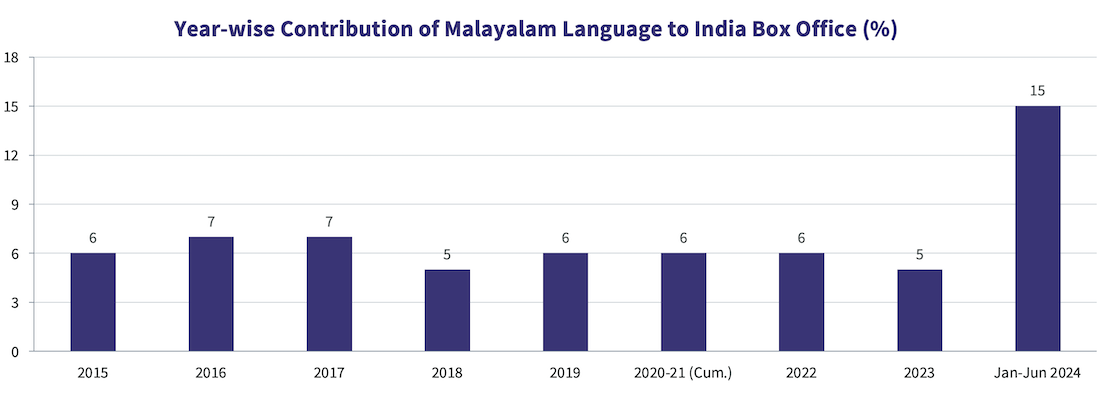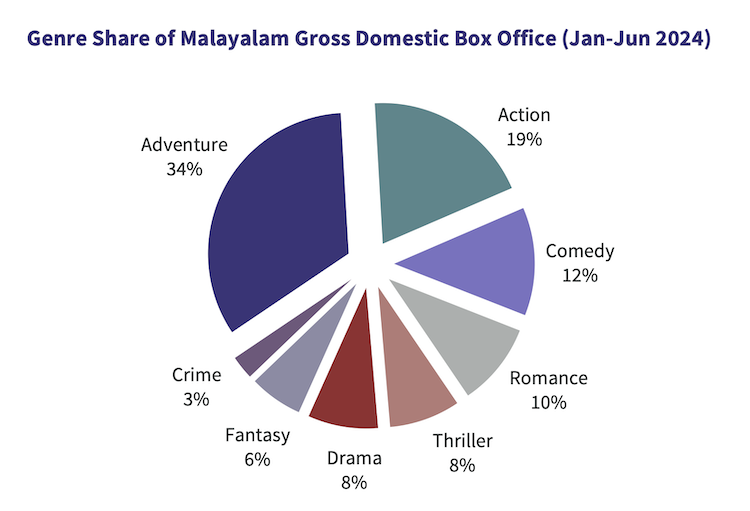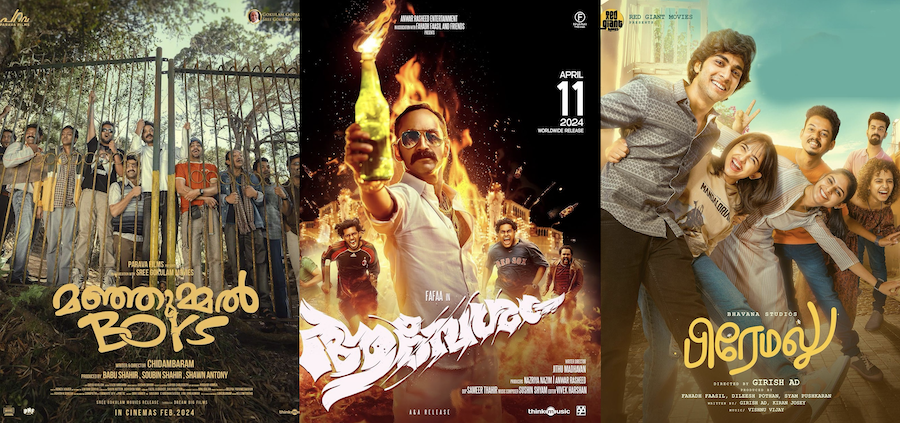


By Amit Bhatia, Visakh Roji
The first six month of 2024 have been nothing short of remarkable for Malayalam cinema. The industry has managed to amass gross collections of ₹743 Cr in Jan-Jun 2024, already substantially higher than its total collections over the entire calendar years of 2022 ((₹633 Cr) and 2023 (₹572 Cr). This has resulted in a significant increase in Malayalam Cinema’s contribution to the India box office in 2024 thus far, compared to the previous years. Read more here, in our mid-year box office report.

At 15% contribution share in 2024 so far, the Malayalam box office has managed to triple its share compared to 2023. What has led to this dramatic growth? A genre-level break up of Malayalam box office in 2024 highlights how disparate and diverse films have managed to garner audience attention.

The chart above illustrates how Malayalam box office is not dependent on a select few genres. The share of Action genre of Malayalam box office (19%) is significantly lower than that for Hindi (23%), Telugu (26%), and Tamil (42%) in the first half of 2024. This shows that the growth story for Malayalam cinema is unique, with the industry relying on contribution from films of various genres, both big and small in scale. This trend is in sharp contrast to other languages, where the box office has largely been driven by the action genre, or by franchise films, especially in the post-pandemic era.
The top Malayalam films of the year so far belong to a variety of genres with Manjummel Boys (Adventure/ True Story), Aadujeevitham - The Goat Life (Adventure), Premalu (Romance), Aavesham (Action), Vashangalkku Shesham (Drama), and Brahmyugam (Horror), highlighting the trend of diversity in Malayalam cinema in 2024.

A deep-dive into the social-cultural and historical factors, as well as the taste preferences of Malayalam film audiences, reveals an insight into how such diverse content manages to find traction.
An evolved audience, relative to rest of India
At a societal level, the state of Kerala has significantly higher rate of literacy (96%) compared to other major states in the country (Maharashtra: 85%, Punjab: 84%, Uttar Pradesh:73%, Telangana: 73%, etc.). This results in a film audience that is relatively more educated, and therefore, at an overall level, more discerning and accommodative of diversity. If we look at the top and bottom states in terms of their literacy rates, one can observe a correlation between lower literacy rates, and the demand for big-scale action films that are low on realism.
Additionally, there is strong history of influence of Malayalam literature on the state’s cinematic landscape over the years. Literary adaptations became a norm in Malayalam cinema, and authors began to seamlessly transition into scriptwriters fostering a rich tapestry of storytelling rooted in Kerala's cultural ethos. Audiences being well-versed with the works of renowned authors and literary classics enabled the state’s cinema to organically gravitate towards content-driven narratives.
The literary landscape in Kerala has long been a fertile ground for cinematic inspiration, with adaptations often mirroring the quality and depth of their source material. A prime example from the 1960s is the adaptation of Thakazhi Sivasankara Pillai's literary work into the acclaimed film Chemmeen, directed by Ramu Kariat, in 1965. This film not only became a box office success, but also clinched the prestigious Best National Film Award of the year. Such instances highlight the symbiotic relationship between literature and cinema flourishing in Kerala. Notable authors like PA Basheer have also seen their literary masterpieces find new life on the silver screen, further enriching Malayalam cinema with narratives steeped in Kerala's rich literary heritage. Moreover, luminaries such as MT Vasudevan and Padmarajan, known for their literary prowess, ventured into cinema during the 70s and the 80s, and brought great content-driven narratives to Malayalam Cinema. While the number of literary adaptations in Malayalam cinema might have decreased considerably over the years, their influence in terms of shaping content preferences and tastes, cannot be undermined.
An evolved audience often has higher levels of cultural and social awareness, which makes them more receptive to films addressing pertinent social issues, cultural nuances, and historical contexts. As a result, Malayalam cinema often delves into themes such as politics, gender, and class struggles, with a level of authenticity. An evolved audience also can connect better with narratives that challenge societal norms, and believe in ‘real-life heroes’ like in the case of The Great Indian Kitchen, 2018, or Manjummel Boys.
Limited reliance on ‘star power’
Malayalam audience do not compromise on their expectations of quality, even for their most popular stars. A glance at recent box office figures featuring stalwarts like Mammootty and Mohanlal unveils an intriguing story. Despite their star power built over decades of reigning the film industry, the audience only rewarded their films that carried substantive content.
For instance, consider the contrasting performances of two of Mohanlal’s films from 2023. The first one, Alone, garnered a modest ₹1 Cr in lifetime box office collections, and the second one, Neru, soared to an impressive ₹47 Cr (domestic gross figures). Neru highlighted a progressive idea like consent, and how a survivor of abuse fights back, while the former is more of a generic thriller. This highlights how audiences prioritize compelling narratives over star power, displaying such contrasting fates for two movies of the same star. Even niche, indie or boldly artistic ventures like Nanpakal Nerathu Mayakkam and Kaathal - The Core managed to garner respectable collections, showcasing the audience's openness to exploring and experiencing diverse and great cinematic experiences. This is in complete contrast to the prevailing trend among top stars in other South Indian languages, where often a minimum threshold for box office earnings, especially on the first day, is guaranteed based on star power alone.
Gradual ‘massification’ of content
The trajectory of Malayalam cinema has been inherently intertwined with financial constraints, primarily stemming from the limited theatrical exposure of Malayalam films. Unlike their counterparts in Hindi and other South Indian industries, Malayalam filmmakers faced logistical and budgetary restrictions due to the smaller revenue market size outside Kerala. Until the emergence of some outliers like Manjummel Boys in 2024, Malayalam films struggled to earn significant theatrical revenues beyond the state’s borders. This focus necessitated a shift in strategy for filmmakers, who had to ensure profitability primarily within Kerala's theatrical market. The inability to delve into large-scale, high-budget films has compelled creators to prioritize their content over extravagant production values.
At the same time, the success of mass-spectacle and commercial movies from neighboring industries (Tamil, Telugu & Kannada) among the Malayalam film audience, brings to light the diverse palette of the these audience. Films like Baahubali 2, Leo, Jailer, K.G.F. Chapter 2, Vikram, etc., delivered good numbers in the state, in original or dubbed versions, demonstrating that the Malayalam audience is not averse to indulging in cinematic experiences that are steeped in grandeur and spectacle, when there’s a certain quality on offer. This success has given impetus to certain Malayalam creators to attempt action and scale-driven narratives within then industry’s fold. A film like Aavesham displays a shift, showcasing how Malayalam filmmakers are beginning to crack the code of crafting mass-action films without sacrificing substance.
Conclusion: A cultural mosaic
Within the diverse and rich heritage of Indian cinema, the Malayalam film industry stands as a testament to Kerala's rich cultural heritage and literary prowess. While literacy may have laid the groundwork to shape the tastes and preferences of film audience in the state, a myriad of other influences (including the rise of streaming platforms) will continue to play a role in the industry’s performance going forward.
As the industry continues to evolve, one thing remains clear: That in Kerala, content will always be the king.

Product update: Content testing for the horror genre
Based on our accumulated audience insights, we are introducing genre-specific drivers for horror films and series in our content testing tools, Ormax Moviescope and Ormax Stream Test

The India Box Office Report: October 2025
Driven by Kantara - A Legend: Chapter-1, October 2025 has emerged as the highest-grossing box office month of the year at the India box office, with gross collections of ₹1,669 Cr

Venn It Happens: SVOD & Theatrical audience intersection
The second edition of our new feature Venn It Happens illustrates the intersection between SVOD and Theatrical audiences in India, using data from Ormax Media's industry reports
Subscribe to stay updated with our latest insights
We use cookies to improve your experience on this site. To find out more, read our Privacy Policy